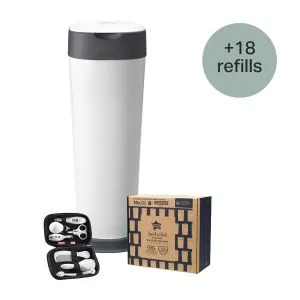
Ultimate XL Nappy Disposal Bundle with 18 Refills
Bundle & Save 40%
Subscription orders can be cancelled at anytime. Free delivery on all subsequent subscription orders. Find out more about subscriptions.
They’re easy and fuss free
Your products are automatically sent to you
You save up to 10% when you sign up for a subscription
You can cancel at any time

Creating the perfect baby nursery is an exciting (but sometimes overwhelming) task. It's a space where your baby will sleep, play, and grow, so it needs to be both beautiful and functional.
We’ve written this post to help you design a dreamy and practical nursery and share some tips and tricks to make the process as enjoyable and stress-free as possible.
Before we get started, it’s important to note that your baby should always be in the same room as you when they’re asleep for the first six months of their life. But that doesn't mean you can’t get their own bedroom sorted ahead of time!
A nursery should be a safe, comfortable, and functional space for your baby.
Here's a breakdown of the essentials:
*T&C bin individually twists and wraps each nappy, locking away odours and germs. Antibacterial protection is present in the film and not the other components of this product. Film is treated with Biomaster silver biocide tested to ISO 22196-2011. Please use biocides responsibly.
A day bed: Perfect for you to nap when baby naps during the day, and practical if you ever need to sleep in baby’s room with them during the night. The nursery should also be a comfortable space for you, as you'll be spending a lot of time there.
Remember, the most important thing is to create a practical space that you and your baby will love.
Explore the Range
A nursery should be a calming and functional space for your baby. Here's what to consider:
Nursery trends come and go. Choose a design that you love and that will stand the test of time. You can always add trendy touches with accessories that are easy to change.
Whatever style nursey you go for, try to choose furniture and decor that can adapt as your baby grows, and remember that the nursery you create should reflect your personal style and be a space that you and your baby love.
Creating a nursery is an exciting process, and the design possibilities are endless! Whether you're working with a large space or a cosy box room, there are plenty of ways to create a beautiful and functional room for your baby.
Looking for some inspiration to help you get started? We’ve got you!
The cost of creating a baby nursery can vary wildly depending on your choices. You can do it on a tight budget or spend a lot for a luxurious space. It's a good idea to create a budget and track your expenses to stay on track.
Here are our top five tips for saving money when creating your baby’s nursery:
No, you don't have to have a dedicated nursery. Many families successfully raise children without one. The most important thing is to create a safe and comfortable sleeping environment for your baby, whether it's in a separate room or in your own bedroom.
Consider your needs, your resources, and your parenting style to make the best decision for your family. You can always create a nursery later if your circumstances change or if you find that you need one.
Whether or not you need a dedicated nursery for your baby is a matter of personal preference and circumstances. There's no single right answer.